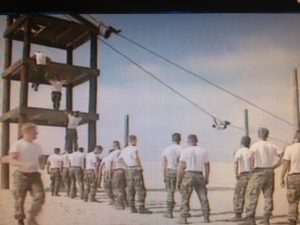The Navy SEAL BUD/S training qualifications are legendary for their difficulty, setting a high bar that few can clear. These elite warriors undergo one of the most demanding military training programs on the planet. Understanding the full scope of what it takes is the first step on a long and arduous journey.
Becoming a member of a SEAL team is an incredible accomplishment that begins with meeting a long list of strict prerequisites. This guide breaks down the essential requirements to see if you have the foundation to begin the path. It all starts long before a candidate ever sets foot on the grinder in Coronado.

Table of Contents:
- Physical Fitness Requirements
- Age and Citizenship Requirements
- Education and ASVAB Scores
- Medical Requirements
- Mental Toughness
- The Officer and Enlisted Paths
- Swimming and Water Comfort
- Background Check
- The Application Process
- Training Pipeline
- Success Rates
- Preparation Tips
- Conclusion
Physical Fitness Requirements
First and foremost, you must possess an exceptional level of physical fitness. The Navy SEAL Physical Screening Test (PST) is the initial gatekeeper, and the standards are not suggestions. To even be considered, you must meet the following minimums.
- 500-yard swim using breaststroke or sidestroke in 12:30 or less.
- 50 push-ups in 2 minutes.
- 50 sit-ups in 2 minutes.
- 10 pull-ups in 2 minutes.
- 1.5-mile run in boots and pants in 10:30 or less.
These are the absolute minimum scores required. To be a competitive candidate, your goal should be to exceed these numbers far. For example, a competitive swim time is under 9 minutes, with push-ups and sit-ups approaching 100 repetitions and pull-ups over 20.
The intense physical training during BUD/S is designed to break you, so entering the training program at the minimum level is a recipe for failure. An operations mentor can help guide prospective seal candidates on their fitness journey. This navy physical standard is the foundation for all subsequent training.
Age and Citizenship Requirements
The basic training requirements are non-negotiable for all applicants. Every potential Navy SEAL candidate must meet these fundamental criteria. There is very little flexibility on these points.
- You must be between the ages of 17 and 28. Waivers for candidates up to age 30 are sometimes available for exceptionally qualified individuals, but they are rare.
- You must be a U.S. citizen.
- You must be able to obtain a secret security clearance. This involves a detailed background check into your personal history and character.
The age window is strict because the rigorous training and operational tempo take a significant physical toll. The Navy seeks candidates who are mature enough to handle the responsibility but young enough to have a long career. Meeting these initial SEAL requirements is just the first hurdle.
Education and ASVAB Scores
Academic and cognitive abilities are just as important as physical prowess. A high school diploma or GED equivalent is the minimum educational requirement. While a college degree is not mandatory for enlisted candidates, it is required for anyone wishing to become a SEAL officer.
The Armed Services Vocational Aptitude Battery (ASVAB) is a critical test you must pass. This vocational aptitude battery measures your cognitive abilities and aptitude for military jobs. To qualify for SEAL training, your ASVAB score must meet specific minimums.
The Navy uses line scores derived from different subtests of the Armed Services Vocational Aptitude Battery. You must score at least the following: GS+MC+EI = 170 or more, or VE+MK+MC+CS = 220 or more. The “CS” in this calculation refers to Coding Speed, highlighting the need for quick information processing.
Meeting the minimum armed services vocational aptitude battery score is essential, as it demonstrates you have the mental capacity to learn and apply the complex skills needed in naval special warfare. The services vocational aptitude battery is a major stepping stone in the qualification process.
Medical Requirements
SEAL candidates must be in excellent health to withstand the harsh environments they will face. A comprehensive medical exam is performed to screen for any disqualifying conditions. The physical demands of basic underwater demolition/seal training are extreme, and your body must be able to handle it.
Vision standards are particularly strict. Your vision in your worst eye cannot be worse than 20/70, and your best eye cannot be worse than 20/40. Both eyes must be correctable to 20/25.
Color blindness is also a disqualifier. SEALs must be able to differentiate colors for tasks like reading maps, identifying signals, and disarming explosives. Other common medical disqualifiers include a history of asthma, significant hearing loss, heart conditions, or chronic joint issues.
| Condition | Reason for Disqualification |
|---|---|
| Poor Vision | Inability to meet 20/70 (worst eye) and 20/40 (best eye) standards, uncorrectable to 20/25. |
| Color Blindness | Compromises ability to perform critical tasks like map reading and signal identification. |
| History of Asthma | High risk of respiratory distress during dive training and high-altitude operations. |
| Significant Hearing Loss | Interferes with underwater communication and battlefield awareness. |
| Chronic Joint Problems | Inability to withstand constant load-bearing, running, and high-impact activities. |
Mental Toughness
Physical fitness gets you to the starting line, but mental toughness gets you to the finish. BUD/S training is engineered to find your breaking point. The instructors are looking for individuals who can remain calm, think clearly, and perform under immense physical and psychological stress.
Grit, determination, and an unwavering will to succeed are essential traits. This is most famously tested during Hell Week, a five-and-a-half-day ordeal in the First Phase of training. During Hell Week, navy seal candidates are pushed to their absolute limits with less than four hours of sleep for the entire duration.
They face constant cold, wetness, and continuous physical tasks. It is here that many aspiring SEALs voluntarily quit. The purpose is to weed out those who lack the mental fortitude to continue when every part of their body and mind is screaming to stop.
The Officer and Enlisted Paths
There are different pathways to BUD/S, primarily divided between officer and enlisted candidates. A prospective SEAL officer has additional requirements, including possessing a four-year college degree. Commissioning sources for officers include the U.S. Naval Academy, Navy ROTC units at universities, or Officer Candidate School (OCS).
An officer candidate will go through the same BUD/S pipeline but is expected to lead from the front. They are evaluated not only on their individual performance but also on their ability to lead the boat crew and class. While any duty officer can theoretically apply, competition is fierce, and a background in challenging fields is advantageous.
The Navy is a diverse organization, and candidates can come from various backgrounds, including support roles like human resources or public affairs. Even a mass communication specialist or a member of the Supply Corps can apply if they meet all the primary qualifications. However, the vast majority of SEAL candidates join the Navy with the specific goal of entering the special warfare community.

Swimming and Water Comfort
The “SE” in SEAL stands for Sea, and comfort in the water is paramount. SEALs are fundamentally a maritime special operations force and a significant portion of their training is water-based. It’s not enough to be a good swimmer; you must be completely at home in the aquatic environment, even under extreme duress.
The roots of the community trace back to the Underwater Demolition Teams (UDT) of World War II, a legacy reflected in the name of the school: Basic Underwater Demolition/SEAL School. This SEAL history of underwater demolition is why water competency is tested so harshly. You will learn combat diving with and without breathing apparatus in both open and closed-circuit systems.
Training evolutions like “drown-proofing,” where candidates’ hands and feet are bound, test their ability to stay calm and survive in the water. Many candidates who are otherwise strong athletes fail during the pool competency portions of BUD/S. Fear of the water or an inability to handle the stress of underwater demolition/seal tasks will quickly lead to elimination from the program.
Background Check
Integrity is a core tenet of the Naval Special Warfare community. Every candidate undergoes an extensive background investigation to qualify for a secret security clearance. The Navy is looking for individuals with high moral character and a history of making responsible decisions.
This check will scrutinize your past for any red flags. A criminal record, history of drug use, or financial irresponsibility can be disqualifying. Be completely honest throughout the process, as any attempt to conceal information will result in immediate disqualification.
The Application Process
If you believe you meet the Navy SEAL requirements, the first step is to contact a Navy recruiter. You will need to express your interest in the SEAL challenge contract. This contract guarantees you a spot at BUD/S if you successfully complete boot camp and subsequent preparatory training.
Here’s a simplified overview of the initial steps:
- Contact a Navy Recruiter and a Naval Special Warfare/Special Operations Mentor.
- Take the ASVAB and meet the minimum line scores for the special warfare/special operator rating.
- Pass the initial medical screening and the PST with competitive scores.
- Receive a SEAL contract and ship to Navy Recruit Training Command (Boot Camp).
- Attend the eight-week Naval Special Warfare Preparatory School in Great Lakes, Illinois, focusing on improving fitness and water skills.
- Report to Coronado, California, to begin BUD/S training.
Many individuals fail to even make it to BUD/S. The preparatory school has its own attrition rate, ensuring that only the most prepared candidates attend the main course. It’s a continuous process of selection.
Training Pipeline
Completing BUD/S is not the end of the journey; it is only the beginning of a long training SEAL pipeline. The initial phase is Basic Underwater Demolition/SEAL (BUD/S) itself, which is broken into three phases.
- First Phase (Basic Conditioning): This 7-week phase focuses on physical conditioning, teamwork, and mental toughness. It includes Hell Week, log PT, and endless running and swimming.
- Second Phase (Diving): An 8-week phase dedicated to combat diving. This is the underwater demolition portion, where SEAL candidates learn to use SCUBA for combat and tactical scenarios.
- Third Phase (Land Warfare): This 9-week phase takes place on San Clemente Island. Candidates learn basic demolitions, reconnaissance, and land warfare tactics, including weapons handling and small-unit strategy.
After graduating from BUD/S, candidates are not yet SEALs. They must complete SEAL Qualification Training (SQT), a 26-week advanced course. SQT training includes marksmanship, communications, small boat operations, close-quarters combat, and survival training before candidates finally earn the coveted Navy SEAL Trident.
After earning the Trident, they are assigned to a SEAL Team and will continue specialized training for missions that may include direct action, special reconnaissance, or foreign internal defense.
Success Rates
The numbers speak for themselves: the path to becoming a Navy SEAL is one of the most selective in any military. The attrition rate for BUD/S training is consistently high, often hovering between 70-80%. Of the approximately 1,000 candidates who start the program each year, only 200-250 will go on to SQT.
Failure comes from many sources. Some candidates quit due to the sheer physical and mental exhaustion, a process known as Drop on Request (DOR). Others are medically dropped due to injuries, or they fail to meet performance standards on timed runs, swims, or obstacle courses.
Preparation Tips
Improving your odds requires dedicated preparation long before you speak to a recruiter. Focus on a well-rounded fitness regimen that goes beyond the PST. Incorporate long-distance running and swimming, high-repetition calisthenics, and functional strength training.
Work on your mental resilience by seeking out challenging and uncomfortable situations in your daily life. Learn about SEAL history to understand the legacy you wish to join. Most importantly, be brutally honest with yourself about your weaknesses and work tirelessly to improve them.
Conclusion
The Navy SEAL BUD/S training qualifications are a comprehensive test of a person’s physical, mental, and emotional limits. They are designed to identify the small percentage of individuals who can function effectively in the most demanding and high-stakes environments. The journey requires an extraordinary level of commitment and a refusal to quit, no matter the obstacle.
Meeting the SEAL qualification training standards is a monumental task, but it is achievable for those with the right mix of physical talent and mental fortitude. Every SEAL who wears the Trident was once a candidate wondering if they had what it took. The only way to know is to begin the preparation and take the first step on that challenging path.
